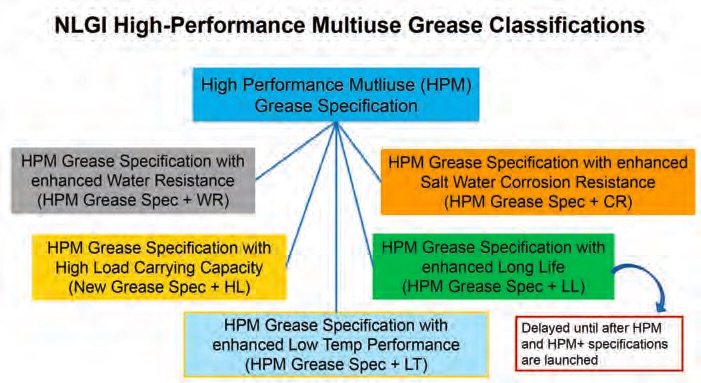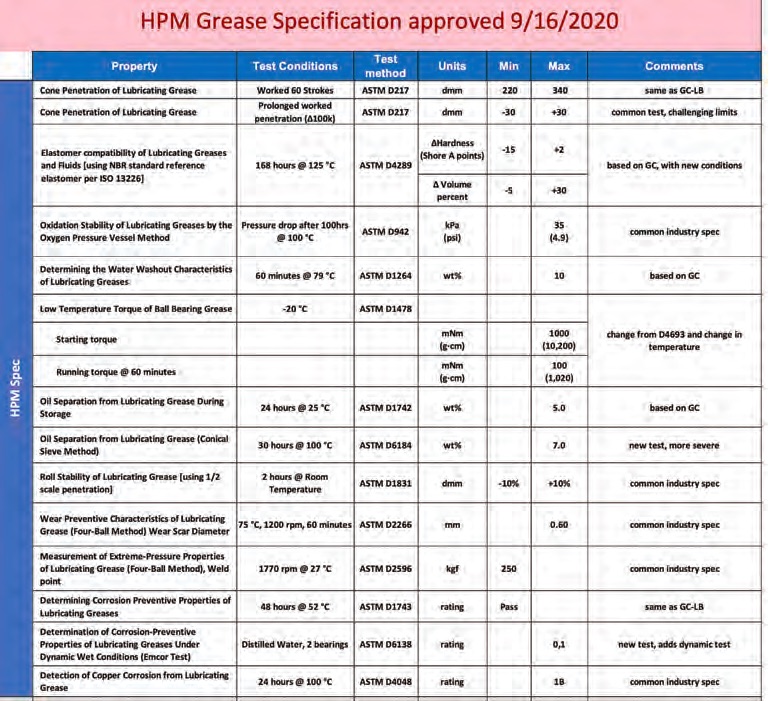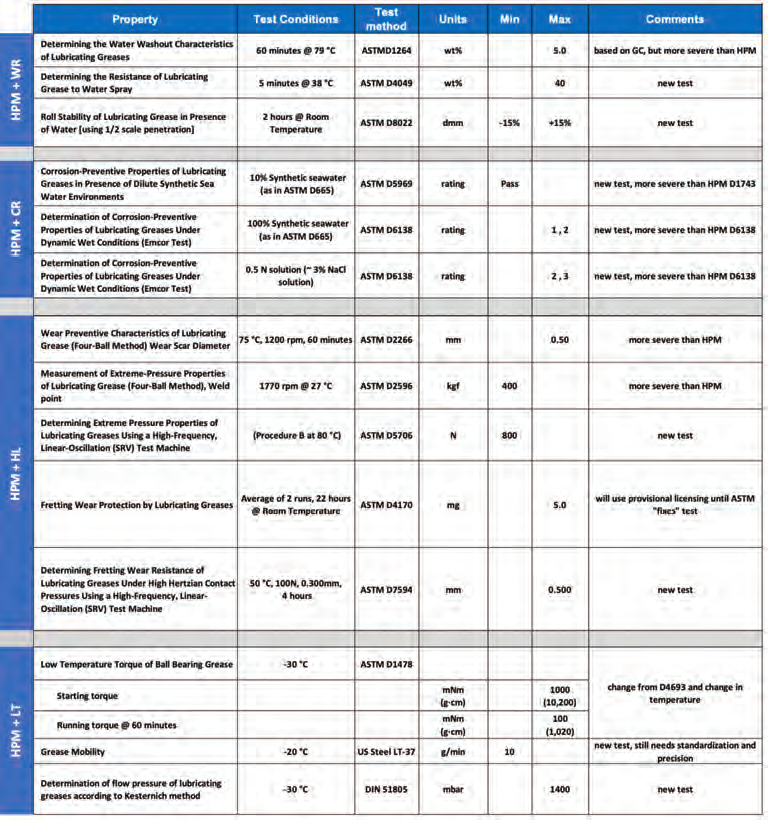History and Goals
NLGI currently licenses lubricating grease through their Certification Mark program which includes the well-known GC-LB Performance Classification. The GC-LB specifications were developed beginning in 1966 and finally published in 1989 as ASTM D4950. This certification program has provided an internationally-recognized grease specification for grease and bearing manufacturers, users, and consumers since that time. Today, over 300 total products are licensed by 85 different companies. Although originally conceived as an automotive chassis and wheel bearing specification for aftermarket service greases, GC-LB today is still recognized as a mark of quality for grease specifiers.
In 2015, NLGI began efforts to upgrade the GC-LB specification due to advancements in materials, technologies, and applications, as well as precision issues with several of the D4950 tests. In July 2019, the decision was made to develop a new set of specifications with higher performance and broader utility to the industry. These new specifications evolved into what today is known as NLGI’s High-Performance Multiuse (HPM) Grease Specifications. An additional goal was to define greases that meet core HPM specification
and sub-categories with tests and limits for
enhanced performance in the following areas (
Figure 1).
 Figure 1. HPM Plus Enhanced Tags
Timeline and Process
Figure 1. HPM Plus Enhanced Tags
Timeline and Process
A steering committee was formed in July 2019 from a cross section of stake holders representing grease manufacturers, marketers, original equipment manufacturers (OEMs), and raw material suppliers. Center for Quality Assurance (CQA) was hired to manage the development of these new specs and to gather industry input into their design. An industry grease expert (Grease Technology Solutions LLC) was brought on board in September 2019 to consult on the project. The proposed grease specification was dubbed High-Performance Multiuse (HPM) grease in November 2019.
Frequently Asked Questions
Will HPM require a certain thickener type or base oil type or additive chemistry?
The answer is “No”. There is no aspect of a grease formulation’s chemistry that is part of the new HPM grease specifications. Since the new specifications are focused on the performance aspect of the greases, there is no restriction put on the raw materials, including thickener type, base oil, additives or, manufacturing processes used to create a product certified as a High-Performance Multiuse grease.
How will the end-user ensure that greases of different chemistries certifying to the HPM specifications will be compatible in real application situations?
Because the HPM and HPM + enhanced specifications are “chemistry neutral”, there is a possibility for different HPM-certified greases to be incompatible, even if the greases are from the same supplier. If NLGI were to include some sort of compatibility requirement in the HPM specifications, it would likely lead to exclusion of some types of grease thickener technologies, which goes against the HPM specification “chemistry neutral” design principles. Given the wide variety of chemistries utilized in grease products, there is no way to include such a compatibility requirement in the HPM specifications.
•
The process started by using draft specifications developed by the steering committee from which interviews were conducted by CQA and GTS (in the fall of 2019 and spring of 2020) with many GC-LB certification holders, end-users, grease manufacturers, marketers, and OEMs. This feedback was reviewed with the steering committee monthly, and the draft specs were iteratively revised.
•
A virtual workshop was held on March 25th with participation from 45 stakeholders from the grease community. Through a lengthy process conducted by the steering committee, the workshop feedback was distilled, evaluated, and finally used to adjust limits in order to gain better consensus.
•
If there was still not good agreement on the proposed limits, the steering committee looked internally at data from their individual companies which could be shared among the committee, and further adjusted the limits and/or test conditions based on consensus analysis of that data.
A webinar was held on June 18th with over 100 participants, many of whom submitted questions. This resulted in the development of a series of Q&As , but no further adjustments were made to the specs, other than a few edits for clarity. During this process, it was decided to delay the development of the High Temperature and Long Life performance tags, since it is likely to take several more years to resolve issues that likely will include the development of at least one new test rig.
After months of effort by the steering committee, with assistance from CQA and GTS, the specification was finalized and approved by the NLGI Board of Directors in September 2020. (
see Tables 1 and 2).
Specification Details
 Table 1. HPM “core” Specification
Table 1. HPM “core” Specification

Table 2. HPM + tag
It should be noted that the HPM and HPM+ specifications are performance specifications.
Trademark and Licensing Process
•
October 2020 – Initial Trademark Filing Begins
•
November 2020 – Application/Qualification Process Begins
•
January 2021 – Companies can start using the mark on products as long as they have received approval
•
January 2021 - June 2021 – Notice of Allowance – Statement of Product (first use of commercial product)
•
Fall 2021 – Trademark Registration Approval
Examples of the certification marks are found in Figure 2.
 Figure 2. Example Certification Marks
Additional Information
How to find more info about the specification and the registration process:
Figure 2. Example Certification Marks
Additional Information
How to find more info about the specification and the registration process:
•
Visit the NLGI website (
www.nlgi.org)
•
Click on the High-Performance Multiuse (HPM) grease button
•
There, you can find the specification, historical information, archived webinars and press releases, as well as instructions for the application process.
Future Plans – HPM and Beyond
After the launch of HPM core specification and enhanced performance sub-categories, NLGI will:
•
Continue work on High Temperature and/or Long Life categories (2 to 5 years) as well as considering initiation of work on other categories as is deemed appropriate.
•
Continue to refine testing and work on current test reproducibility issues in conjunction with ASTM.
•
Adjust or add to specifications as needed to reflect testing capabilities and industry needs with the intention to treat the specifications as “Living Documents.”
•
Continue to encourage active involvement from NLGI membership and industry partners in steering the development process into the future
Please stay tuned for more detailed announcements on HPM pricing and process. Please do not hesitate to contact NLGI HQ at nlgi@nlgi.org or 816-524-2500 in the interim with any questions.